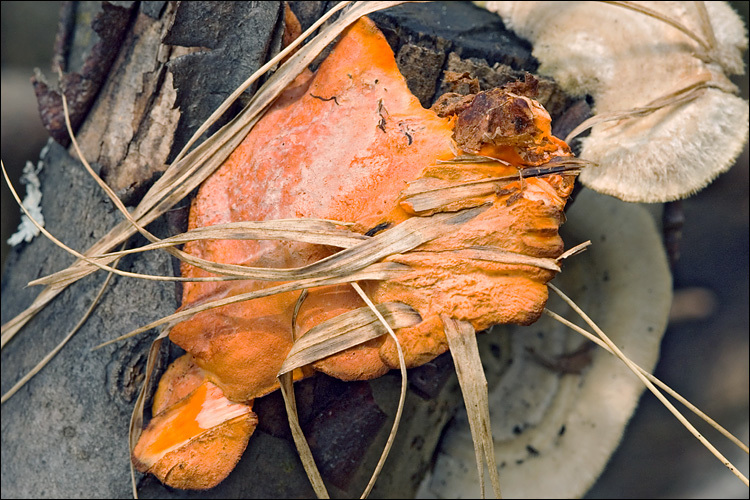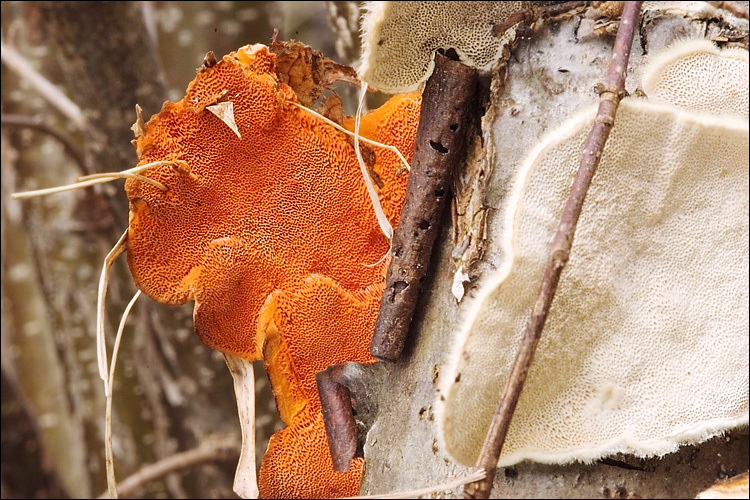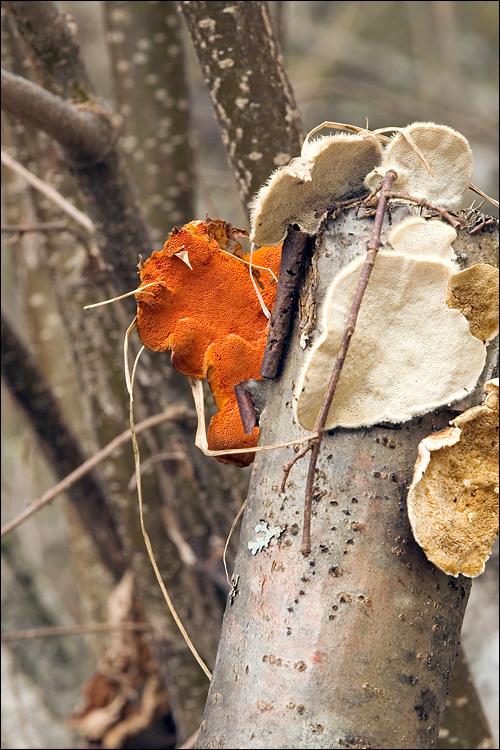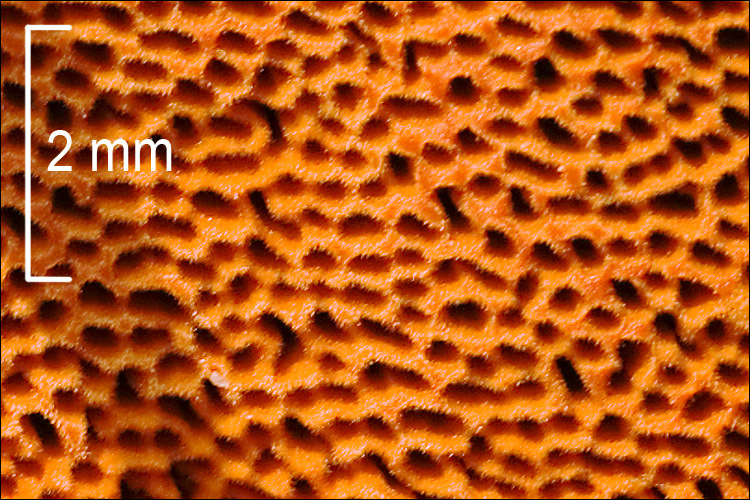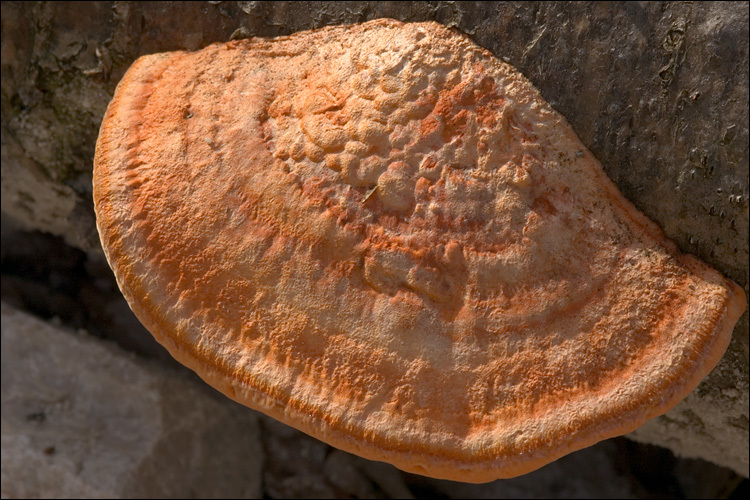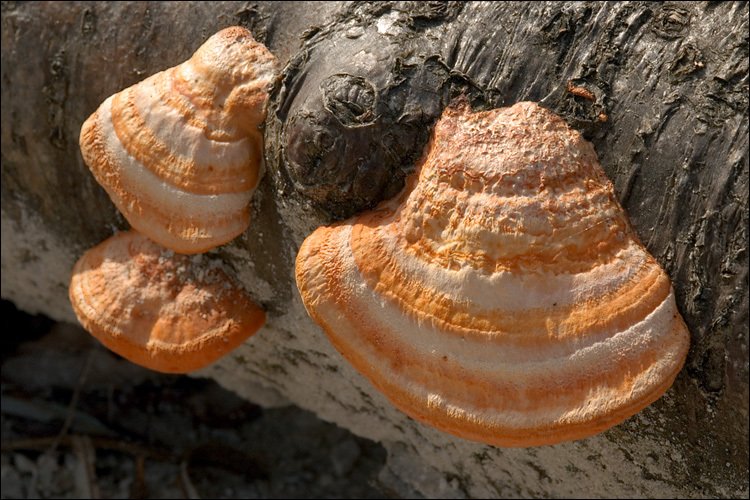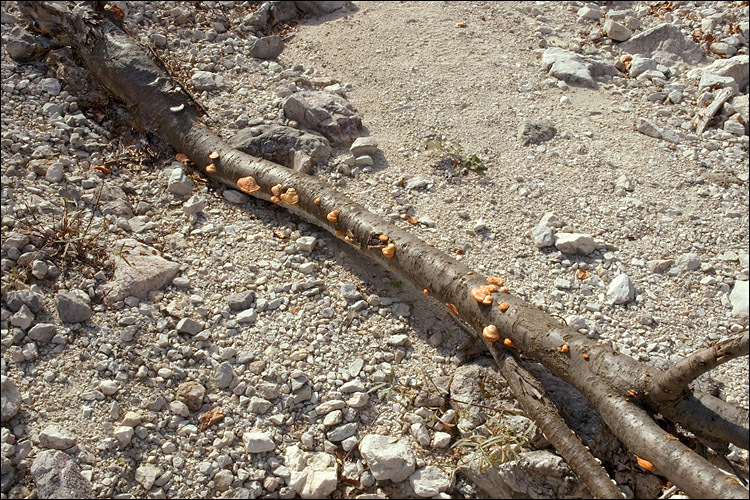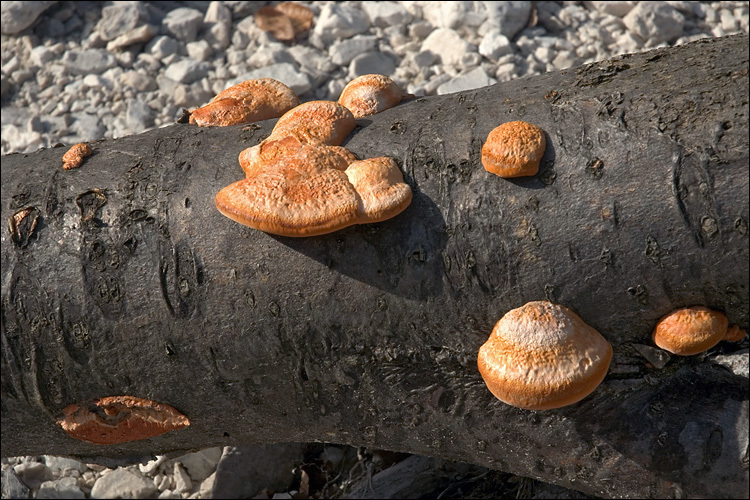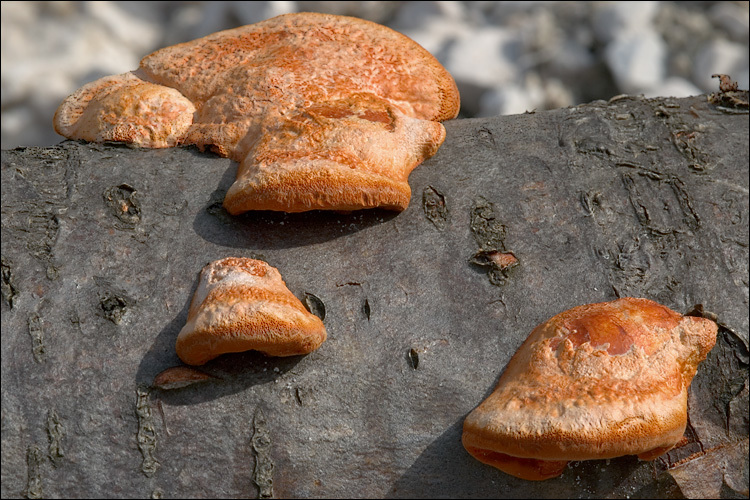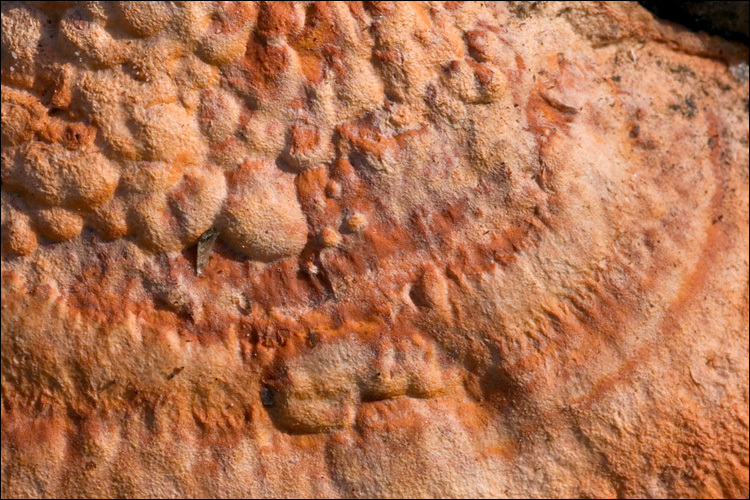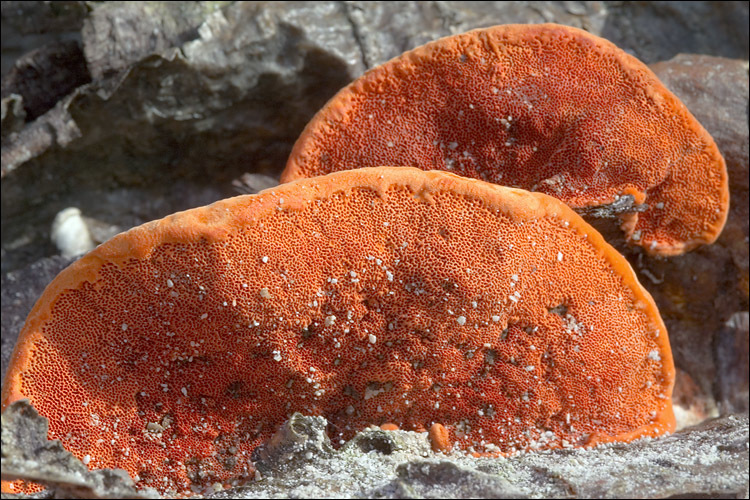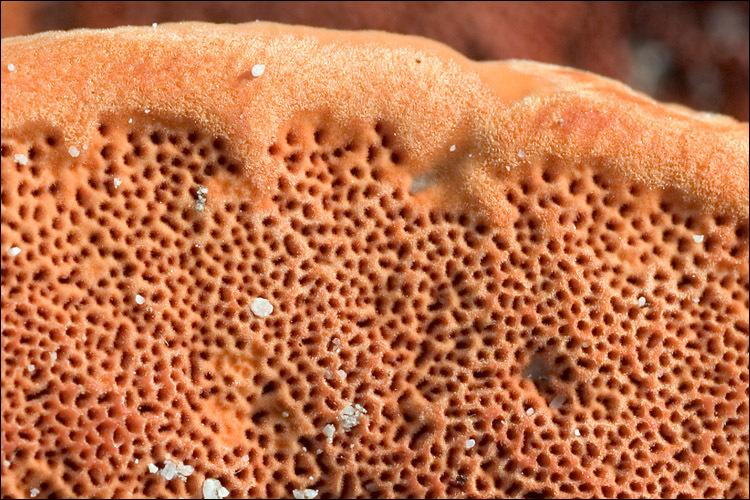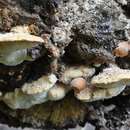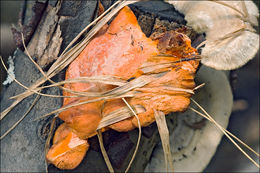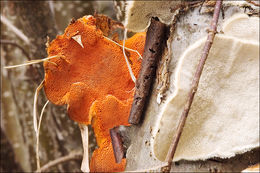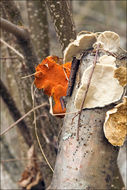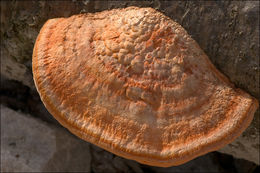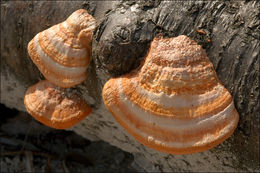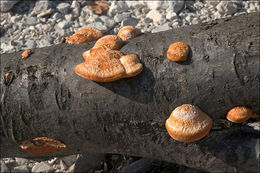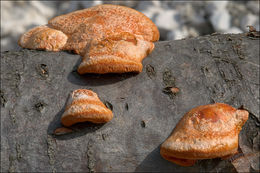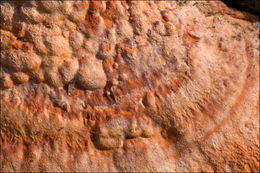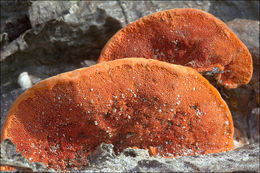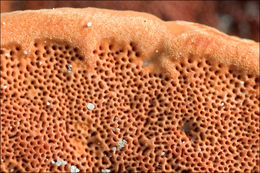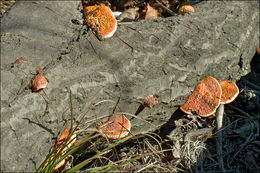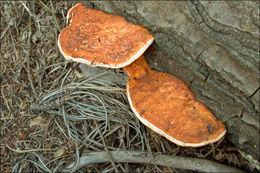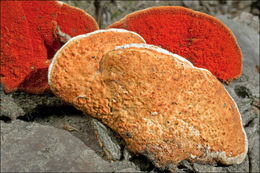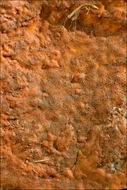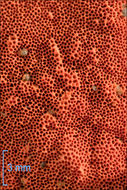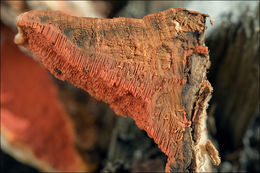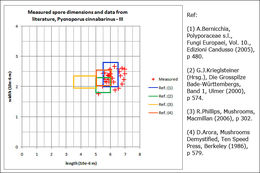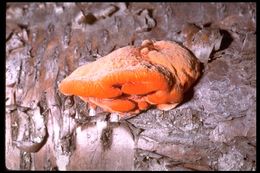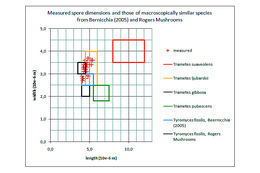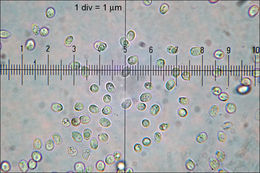-
Slo.: cinobrasti drobnoluknjicar - Habitat: Light forest and bushes, mainly Corylus avelana and Ostrya carpinifolia, NW oriented calcareous mountain slope, quite sunny, exposed to direct rain, precipitations ~3.000 mm/year, average temperature 7-9 deg C, elevation 780 m (2.800 feet), alpine phytogeographical region. Substratum: fallen rotten branch of Corylus avelana
-
Slo.: cinobrasti drobnoluknjicar - Habitat: Light forest and bushes, mainly Corylus avelana and Ostrya carpinifolia, NW oriented calcareous mountain slope, quite sunny, exposed to direct rain, precipitations ~3.000 mm/year, average temperature 7-9 deg C, elevation 780 m (2.800 feet), alpine phytogeographical region. Substratum: fallen rotten branch of Corylus avelana
-
Slo.: cinobrasti drobnoluknjicar - Habitat: Light forest and bushes, mainly Corylus avelana and Ostrya carpinifolia, NW oriented calcareous mountain slope, quite sunny, exposed to direct rain, precipitations ~3.000 mm/year, average temperature 7-9 deg C, elevation 780 m (2.800 feet), alpine phytogeographical region. Substratum: fallen rotten branch of Corylus avelana
-
Slo.: cinobrasti drobnoluknjicar - Habitat: Light forest and bushes, mainly Corylus avelana and Ostrya carpinifolia, NW oriented calcareous mountain slope, quite sunny, exposed to direct rain, precipitations ~3.000 mm/year, average temperature 7-9 deg C, elevation 780 m (2.800 feet), alpine phytogeographical region. Substratum: fallen rotten branch of Corylus avelana
-
Slo.: cinobrasti drobnoluknjicar - Habitat: Light forest and bushes, mainly Corylus avelana and Ostrya carpinifolia, NW oriented calcareous mountain slope, quite sunny, exposed to direct rain, precipitations ~3.000 mm/year, average temperature 7-9 deg C, elevation 780 m (2.800 feet), alpine phytogeographical region. Substratum: fallen rotten branch of Corylus avelana
-
Slo.: cinobrasti drobnoluknjiar
-
Slo.: cinobrasti drobnoluknjiar
-
Slo.: cinobrasti drobnoluknjiar
-
Slo.: cinobrasti drobnoluknjiar
-
Slo.: cinobrasti drobnoluknjiar
-
Slo.: cinobrasti drobnoluknjiar
-
Slo.: cinobrasti drobnoluknjiar
-
Slo.: cinobrasti drobnoluknjiar
-
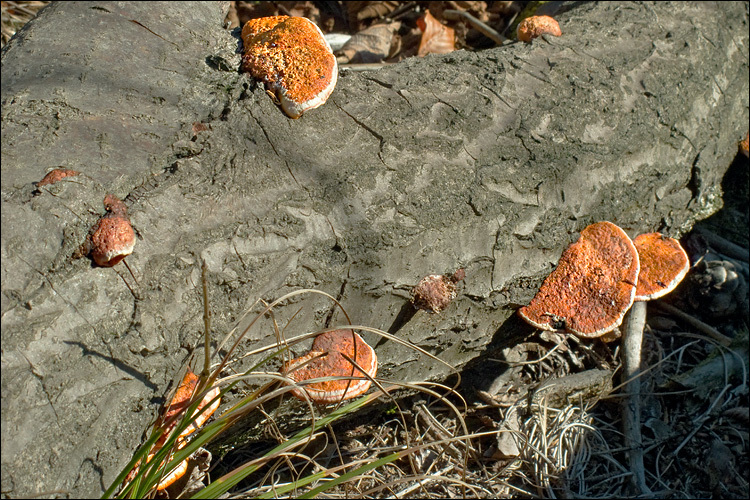
Slo.: cinobrasti drobnoluknjičar - Habitat: Soča river shore, a man made cut in the mixed forest (Pinus sp. and Picea abies dominant) made after a windbreak, south oriented slope, calcareous ground (conglomerate), humid air, sunny and relatively warm place, exposed to direct rain, average precipitations ~ 3.000 mm/year, average temperature 8-10 deg C, elevation 405 m (1.350 feet), alpine phytogeographical region. - Substratum: Fallen broadleaf tree trunk on ground, partly disintegrated but still in bark. - Comments: Growing in groups, more than 20 fruit bodies; pileus width up to 10 cm (4 inch) and up to 2.5 cm (one inch) thick; smell mild, pleasant, on leather. Caps color orange-red-yellow (oac691) with whitish-pink rounded edge, pore surface saturated carmine red, trama rusty brown (oac642); SP faint whitish (?). - Spores smooth, cylindrical, slightly curved. Dimensions: 6.1 (SD = 0.5) x 2.3 (SD = 0.3) micr., Q = 2.65.(SD = 0.14), n = 30. Motic B2-211A, magnification 1.000 x, oil, in water. Congo red. - Ref.: (1) A.Bernicchia, Polyporaceae s.l., Fungi Europaei, Vol. 10., Edizioni Candusso (2005), p 480. 5.5-6.5/2-2.8 (2) G.J.Krieglsteiner (Hrsg.), Die Grosspilze Bade-Wrttembergs, Band 1, Ulmer (2000), p 574. 5-6/1.8-2.3 (3) R.Phillips, Mushrooms, Macmillan (2006), p 302. 3.5-5/2-3 (4) D.Arora, Mushrooms Demystified, Ten Speed Press, Berkeley (1986), p 579. 5-6/2-2.5
-
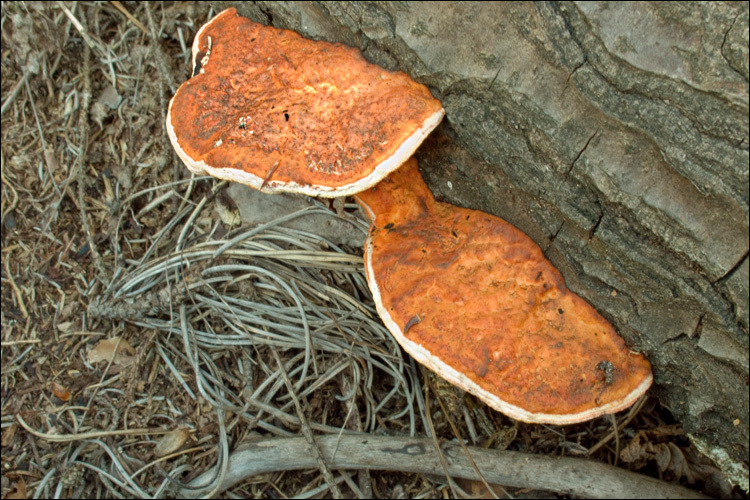
Slo.: cinobrasti drobnoluknjičar - Habitat: Soča river shore, a man made cut in the mixed forest (Pinus sp. and Picea abies dominant) made after a windbreak, south oriented slope, calcareous ground (conglomerate), humid air, sunny and relatively warm place, exposed to direct rain, average precipitations ~ 3.000 mm/year, average temperature 8-10 deg C, elevation 405 m (1.350 feet), alpine phytogeographical region. - Substratum: Fallen broadleaf tree trunk on ground, partly disintegrated but still in bark. - Comments: Growing in groups, more than 20 fruit bodies; pileus width up to 10 cm (4 inch) and up to 2.5 cm (one inch) thick; smell mild, pleasant, on leather. Caps color orange-red-yellow (oac691) with whitish-pink rounded edge, pore surface saturated carmine red, trama rusty brown (oac642); SP faint whitish (?). - Spores smooth, cylindrical, slightly curved. Dimensions: 6.1 (SD = 0.5) x 2.3 (SD = 0.3) micr., Q = 2.65.(SD = 0.14), n = 30. Motic B2-211A, magnification 1.000 x, oil, in water. Congo red. - Ref.: (1) A.Bernicchia, Polyporaceae s.l., Fungi Europaei, Vol. 10., Edizioni Candusso (2005), p 480. 5.5-6.5/2-2.8 (2) G.J.Krieglsteiner (Hrsg.), Die Grosspilze Bade-Wrttembergs, Band 1, Ulmer (2000), p 574. 5-6/1.8-2.3 (3) R.Phillips, Mushrooms, Macmillan (2006), p 302. 3.5-5/2-3 (4) D.Arora, Mushrooms Demystified, Ten Speed Press, Berkeley (1986), p 579. 5-6/2-2.5
-

Slo.: cinobrasti drobnoluknjičar - Habitat: Soča river shore, a man made cut in the mixed forest (Pinus sp. and Picea abies dominant) made after a windbreak, south oriented slope, calcareous ground (conglomerate), humid air, sunny and relatively warm place, exposed to direct rain, average precipitations ~ 3.000 mm/year, average temperature 8-10 deg C, elevation 405 m (1.350 feet), alpine phytogeographical region. - Substratum: Fallen broadleaf tree trunk on ground, partly disintegrated but still in bark. - Comments: Growing in groups, more than 20 fruit bodies; pileus width up to 10 cm (4 inch) and up to 2.5 cm (one inch) thick; smell mild, pleasant, on leather. Caps color orange-red-yellow (oac691) with whitish-pink rounded edge, pore surface saturated carmine red, trama rusty brown (oac642); SP faint whitish (?). - Spores smooth, cylindrical, slightly curved. Dimensions: 6.1 (SD = 0.5) x 2.3 (SD = 0.3) micr., Q = 2.65.(SD = 0.14), n = 30. Motic B2-211A, magnification 1.000 x, oil, in water. Congo red. - Ref.: (1) A.Bernicchia, Polyporaceae s.l., Fungi Europaei, Vol. 10., Edizioni Candusso (2005), p 480. 5.5-6.5/2-2.8 (2) G.J.Krieglsteiner (Hrsg.), Die Grosspilze Bade-Wrttembergs, Band 1, Ulmer (2000), p 574. 5-6/1.8-2.3 (3) R.Phillips, Mushrooms, Macmillan (2006), p 302. 3.5-5/2-3 (4) D.Arora, Mushrooms Demystified, Ten Speed Press, Berkeley (1986), p 579. 5-6/2-2.5
-

Slo.: cinobrasti drobnoluknjičar - Habitat: Soča river shore, a man made cut in the mixed forest (Pinus sp. and Picea abies dominant) made after a windbreak, south oriented slope, calcareous ground (conglomerate), humid air, sunny and relatively warm place, exposed to direct rain, average precipitations ~ 3.000 mm/year, average temperature 8-10 deg C, elevation 405 m (1.350 feet), alpine phytogeographical region. - Substratum: Fallen broadleaf tree trunk on ground, partly disintegrated but still in bark. - Comments: Growing in groups, more than 20 fruit bodies; pileus width up to 10 cm (4 inch) and up to 2.5 cm (one inch) thick; smell mild, pleasant, on leather. Caps color orange-red-yellow (oac691) with whitish-pink rounded edge, pore surface saturated carmine red, trama rusty brown (oac642); SP faint whitish (?). - Spores smooth, cylindrical, slightly curved. Dimensions: 6.1 (SD = 0.5) x 2.3 (SD = 0.3) micr., Q = 2.65.(SD = 0.14), n = 30. Motic B2-211A, magnification 1.000 x, oil, in water. Congo red. - Ref.: (1) A.Bernicchia, Polyporaceae s.l., Fungi Europaei, Vol. 10., Edizioni Candusso (2005), p 480. 5.5-6.5/2-2.8 (2) G.J.Krieglsteiner (Hrsg.), Die Grosspilze Bade-Wrttembergs, Band 1, Ulmer (2000), p 574. 5-6/1.8-2.3 (3) R.Phillips, Mushrooms, Macmillan (2006), p 302. 3.5-5/2-3 (4) D.Arora, Mushrooms Demystified, Ten Speed Press, Berkeley (1986), p 579. 5-6/2-2.5
-
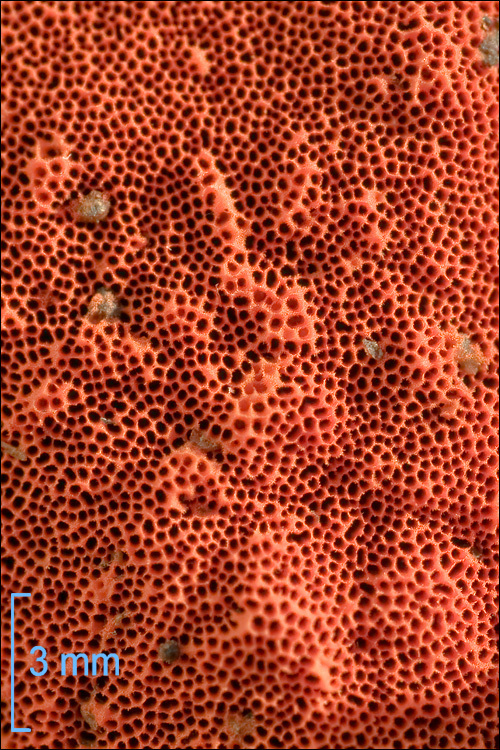
Slo.: cinobrasti drobnoluknjičar - Habitat: Soča river shore, a man made cut in the mixed forest (Pinus sp. and Picea abies dominant) made after a windbreak, south oriented slope, calcareous ground (conglomerate), humid air, sunny and relatively warm place, exposed to direct rain, average precipitations ~ 3.000 mm/year, average temperature 8-10 deg C, elevation 405 m (1.350 feet), alpine phytogeographical region. - Substratum: Fallen broadleaf tree trunk on ground, partly disintegrated but still in bark. - Comments: Growing in groups, more than 20 fruit bodies; pileus width up to 10 cm (4 inch) and up to 2.5 cm (one inch) thick; smell mild, pleasant, on leather. Caps color orange-red-yellow (oac691) with whitish-pink rounded edge, pore surface saturated carmine red, trama rusty brown (oac642); SP faint whitish (?). - Spores smooth, cylindrical, slightly curved. Dimensions: 6.1 (SD = 0.5) x 2.3 (SD = 0.3) micr., Q = 2.65.(SD = 0.14), n = 30. Motic B2-211A, magnification 1.000 x, oil, in water. Congo red. - Ref.: (1) A.Bernicchia, Polyporaceae s.l., Fungi Europaei, Vol. 10., Edizioni Candusso (2005), p 480. 5.5-6.5/2-2.8 (2) G.J.Krieglsteiner (Hrsg.), Die Grosspilze Bade-Wrttembergs, Band 1, Ulmer (2000), p 574. 5-6/1.8-2.3 (3) R.Phillips, Mushrooms, Macmillan (2006), p 302. 3.5-5/2-3 (4) D.Arora, Mushrooms Demystified, Ten Speed Press, Berkeley (1986), p 579. 5-6/2-2.5
-
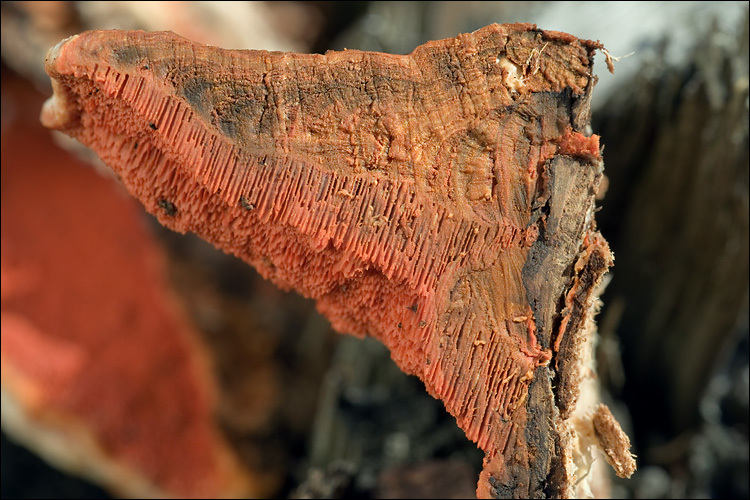
Slo.: cinobrasti drobnoluknjičar - Habitat: Soča river shore, a man made cut in the mixed forest (Pinus sp. and Picea abies dominant) made after a windbreak, south oriented slope, calcareous ground (conglomerate), humid air, sunny and relatively warm place, exposed to direct rain, average precipitations ~ 3.000 mm/year, average temperature 8-10 deg C, elevation 405 m (1.350 feet), alpine phytogeographical region. - Substratum: Fallen broadleaf tree trunk on ground, partly disintegrated but still in bark. - Comments: Growing in groups, more than 20 fruit bodies; pileus width up to 10 cm (4 inch) and up to 2.5 cm (one inch) thick; smell mild, pleasant, on leather. Caps color orange-red-yellow (oac691) with whitish-pink rounded edge, pore surface saturated carmine red, trama rusty brown (oac642); SP faint whitish (?). - Spores smooth, cylindrical, slightly curved. Dimensions: 6.1 (SD = 0.5) x 2.3 (SD = 0.3) micr., Q = 2.65.(SD = 0.14), n = 30. Motic B2-211A, magnification 1.000 x, oil, in water. Congo red. - Ref.: (1) A.Bernicchia, Polyporaceae s.l., Fungi Europaei, Vol. 10., Edizioni Candusso (2005), p 480. 5.5-6.5/2-2.8 (2) G.J.Krieglsteiner (Hrsg.), Die Grosspilze Bade-Wrttembergs, Band 1, Ulmer (2000), p 574. 5-6/1.8-2.3 (3) R.Phillips, Mushrooms, Macmillan (2006), p 302. 3.5-5/2-3 (4) D.Arora, Mushrooms Demystified, Ten Speed Press, Berkeley (1986), p 579. 5-6/2-2.5
-

Slo.: cinobrasti drobnoluknjičar - Habitat: Soča river shore, a man made cut in the mixed forest (Pinus sp. and Picea abies dominant) made after a windbreak, south oriented slope, calcareous ground (conglomerate), humid air, sunny and relatively warm place, exposed to direct rain, average precipitations ~ 3.000 mm/year, average temperature 8-10 deg C, elevation 405 m (1.350 feet), alpine phytogeographical region. - Substratum: Fallen broadleaf tree trunk on ground, partly disintegrated but still in bark. - Comments: Growing in groups, more than 20 fruit bodies; pileus width up to 10 cm (4 inch) and up to 2.5 cm (one inch) thick; smell mild, pleasant, on leather. Caps color orange-red-yellow (oac691) with whitish-pink rounded edge, pore surface saturated carmine red, trama rusty brown (oac642); SP faint whitish (?). - Spores smooth, cylindrical, slightly curved. Dimensions: 6.1 (SD = 0.5) x 2.3 (SD = 0.3) micr., Q = 2.65.(SD = 0.14), n = 30. Motic B2-211A, magnification 1.000 x, oil, in water. Congo red. - Ref.: (1) A.Bernicchia, Polyporaceae s.l., Fungi Europaei, Vol. 10., Edizioni Candusso (2005), p 480. 5.5-6.5/2-2.8 (2) G.J.Krieglsteiner (Hrsg.), Die Grosspilze Bade-Wrttembergs, Band 1, Ulmer (2000), p 574. 5-6/1.8-2.3 (3) R.Phillips, Mushrooms, Macmillan (2006), p 302. 3.5-5/2-3 (4) D.Arora, Mushrooms Demystified, Ten Speed Press, Berkeley (1986), p 579. 5-6/2-2.5
-
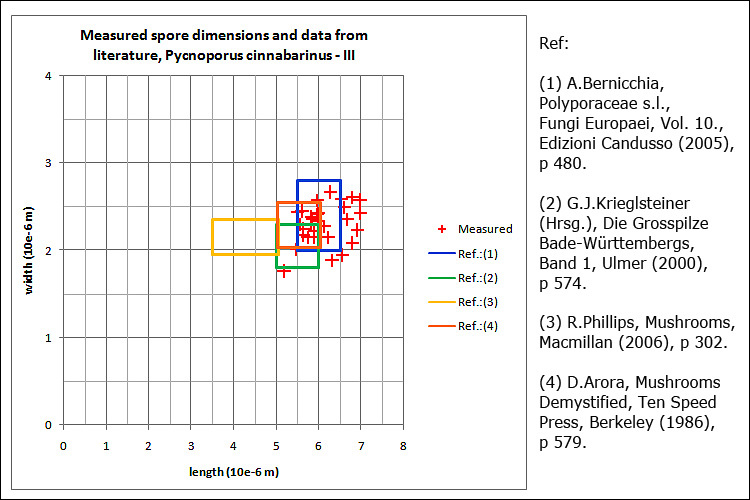
Slo.: cinobrasti drobnoluknjičar - Habitat: Soča river shore, a man made cut in the mixed forest (Pinus sp. and Picea abies dominant) made after a windbreak, south oriented slope, calcareous ground (conglomerate), humid air, sunny and relatively warm place, exposed to direct rain, average precipitations ~ 3.000 mm/year, average temperature 8-10 deg C, elevation 405 m (1.350 feet), alpine phytogeographical region. - Substratum: Fallen broadleaf tree trunk on ground, partly disintegrated but still in bark. - Comments: Growing in groups, more than 20 fruit bodies; pileus width up to 10 cm (4 inch) and up to 2.5 cm (one inch) thick; smell mild, pleasant, on leather. Caps color orange-red-yellow (oac691) with whitish-pink rounded edge, pore surface saturated carmine red, trama rusty brown (oac642); SP faint whitish (?). - Spores smooth, cylindrical, slightly curved. Dimensions: 6.1 (SD = 0.5) x 2.3 (SD = 0.3) micr., Q = 2.65.(SD = 0.14), n = 30. Motic B2-211A, magnification 1.000 x, oil, in water. Congo red. - Ref.: (1) A.Bernicchia, Polyporaceae s.l., Fungi Europaei, Vol. 10., Edizioni Candusso (2005), p 480. 5.5-6.5/2-2.8 (2) G.J.Krieglsteiner (Hrsg.), Die Grosspilze Bade-Wrttembergs, Band 1, Ulmer (2000), p 574. 5-6/1.8-2.3 (3) R.Phillips, Mushrooms, Macmillan (2006), p 302. 3.5-5/2-3 (4) D.Arora, Mushrooms Demystified, Ten Speed Press, Berkeley (1986), p 579. 5-6/2-2.5
-
2001 California Academy of Sciences
CalPhotos
-
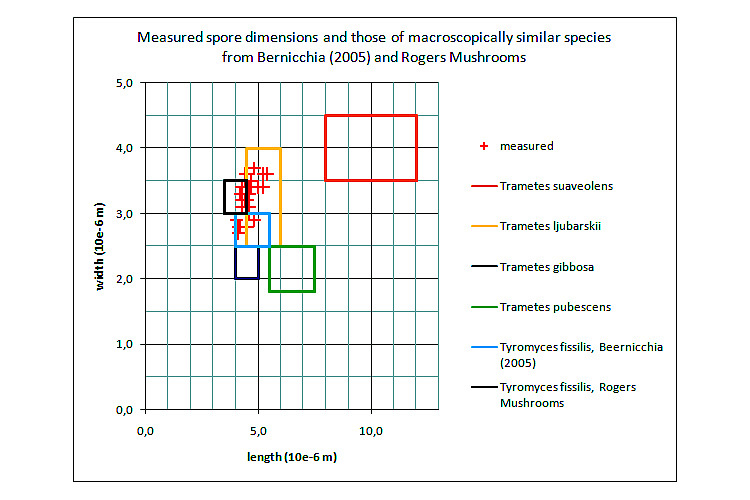
Habitat: Mixed woodland, nearly flat ground, cretaceous clastic rock (flysh), partly rain protected by trees canopies, mostly in shade, average precipitations ~3.000 mm/year, average temperature 8-10 deg C, altitude 435 m (1.450 feet), alpine phytogeographical region. Substratum: fallen rotten deciduous tree, probably Acer sp., partly debarked, covered with mosses. - Place: West of Bovec, near a trail from station A of Mt. Kanin cable car to village Pluna, East Julian Alps, Posoje, Slovenia - Comments: Spore print white. Spore dimensions: 4.6 (SD=0,3) x 3.3 (SD=0,3) micr., Q= 1.42 (SD=0,10), n= 33. Motic B2-211A, magnification 1.000 x, oil, in water. - Many thanks to Dip.ing. of Forestry Gregor Podgornik, Natural History Center (NAC), Tolmin, Slovenia for determination. - Ref.: (1) Personal communication with Gregor Podgornik, NAC, Tolmin, Slovenia. (2) http://www.usask.ca/biology/fungi/genus_species_pages/tyromyces_fissilis.shtml. (3) http://www.rogersmushrooms.com/gallery/DisplayBlock~bid~6906~gid~~source~gallerydefault.asp . (4) http://www.mykonet.ch/images/Porlinge/aurantisporus_fissilis_apfelbaum_saftporling.jpg. (5) A.Bernicchia, Polyporaceae s.l., Fungi Europaei 10, Edizioni Candusso (2005), p 552
-
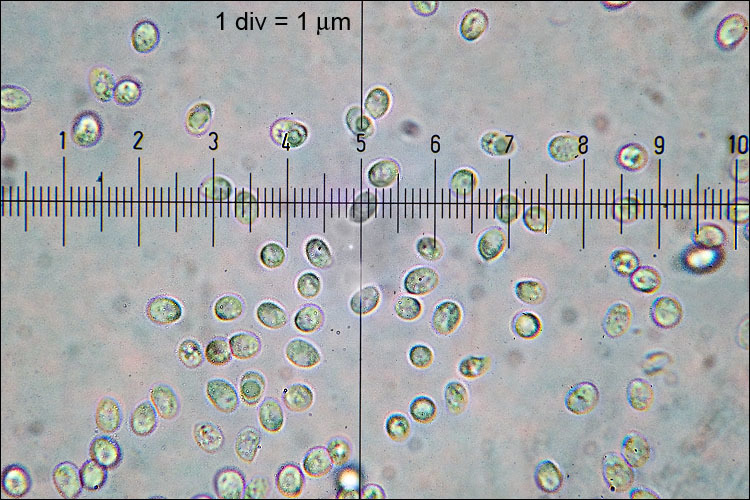
Habitat: Mixed woodland, nearly flat ground, cretaceous clastic rock (flysh), partly rain protected by trees canopies, mostly in shade, average precipitations ~3.000 mm/year, average temperature 8-10 deg C, altitude 435 m (1.450 feet), alpine phytogeographical region. Substratum: fallen rotten deciduous tree, probably Acer sp., partly debarked, covered with mosses. - Place: West of Bovec, near a trail from station A of Mt. Kanin cable car to village Pluna, East Julian Alps, Posoje, Slovenia - Comments: Spore print white. Spore dimensions: 4.6 (SD=0,3) x 3.3 (SD=0,3) micr., Q= 1.42 (SD=0,10), n= 33. Motic B2-211A, magnification 1.000 x, oil, in water. - Motic B2-211A, magnification 1.000 x, oil, in water. - Many thanks to Dip.ing. of Forestry Gregor Podgornik, Natural History Center (NAC), Tolmin, Slovenia for determination. - Ref.: (1) Personal communication with Gregor Podgornik, NAC, Tolmin, Slovenia. (2) http://www.usask.ca/biology/fungi/genus_species_pages/tyromyces_fissilis.shtml. (3) http://www.rogersmushrooms.com/gallery/DisplayBlock~bid~6906~gid~~source~gallerydefault.asp . (4) http://www.mykonet.ch/images/Porlinge/aurantisporus_fissilis_apfelbaum_saftporling.jpg. (5) A.Bernicchia, Polyporaceae s.l., Fungi Europaei 10, Edizioni Candusso (2005), p 552


